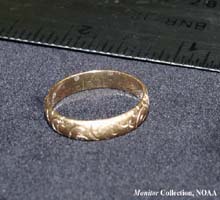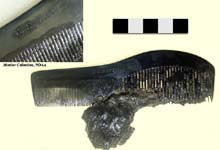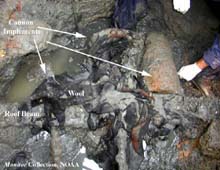
This gold ring was discovered during the excavation of the skeletal remains inside of the Monitor's gun turret. Although there are no identifying marks inside of the ring, it is hoped that the ring will offer researchers a clue to the owner’s identity. Click image for a larger view. Click image for larger view and detailed explanation.

A "hard rubber" comb marked "US Navy" is one of several items recovered from the Monitor's gun turret. Click image for a larger view.
Click image for larger view and detailed explanation.

This image shows the remnants of a sailor's wool coat tangled up around two of the cannon loading implements and concreted to one of the turret roof beams. Click image for a larger view. Click image for larger view and detailed explanation.
Excavation Continues
August 30, 2002
John Broadwater and
Michelle Fox
Monitor National Marine Sanctuary
On August 10, after a very successful recovery expedition, the Monitor's turret arrived safely at The Mariners' Museum in Newport News, Virginia. The museum was well prepared with a huge conservation tank, a computer-controlled chilled-water system to keep the turret submerged in cool water. The chilled water is important for the preservation of organic material known to remain in the turret when it arrived at the museum.
During the week of August 26-30, the turret excavation resumed, this time by a team made up of personnel from the Monitor National Marine Sanctuary, The Mariners' Museum, and the U.S. Army Central Identification Laboratory in Hawaii (CILHI). We were very fortunate once again to have the participation of Eric Emery, CILHI archaeologist, who was part of the archaeology team during the expedition and had directed the recovery of human remains from the turret. Our primary goal for the week was to remove the rest of the human remains and to continue the excavation of sediment and artifacts from within the turret.
The excavation went well, with an enthusiastic team both inside and outside the turret. At least a dozen museum staff participated throughout the week, assisting with logistical needs and screening the scores of buckets of silt and clay that were removed from the turret each day. The museum team was augmented by museum and NOAA volunteers, who cheerfully worked at the messy and dirty screening process. The skies were overcast all week, with frequent intervals of rain, sometimes hard rain. Although the rain made the job even messier, the weather was almost ideal for the excavation. Rain and a sunless sky helped prevent the turret from drying out while the work was taking place.
By the end of the week, we had completed the recovery of two Monitor sailors. No other remains have been found, although it is still possible that additional sailors could be buried in the unexcavated portions of the turret. Our most exciting find was a gold ring, still on the fourth finger of the right hand of one of the two bodies. We received dozens of e-mails and phone calls telling us of various countries in Europe and elsewhere in which wedding rings are worn on the right—rather than left—hand. Since the Monitor's crew included many immigrants, the location of the ring could be a clue to the sailor's identity.
Other artifacts recovered during the week include a silver-plated serving spoon, probably from the pants pocket of one of the two sailors, a pocket comb stamped "U.S. Navy," the handle to a pocket knife, a nearly-complete wool overcoat and numerous coat buttons, three shoes, and pulley blocks associated with the gun carriages.
We will continue to provide updates on this Web site as excavation and research continues.
Sign up for the Ocean Explorer E-mail Update List.

































